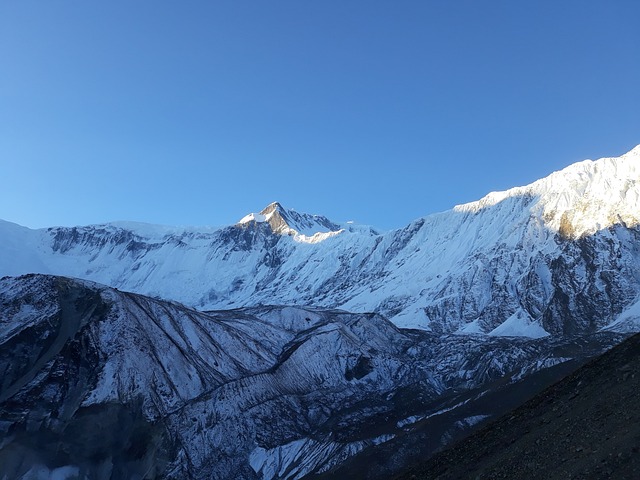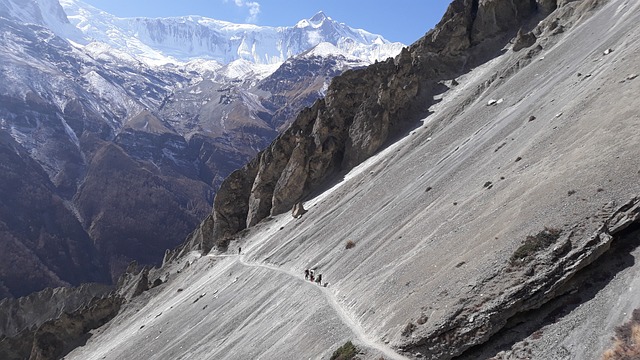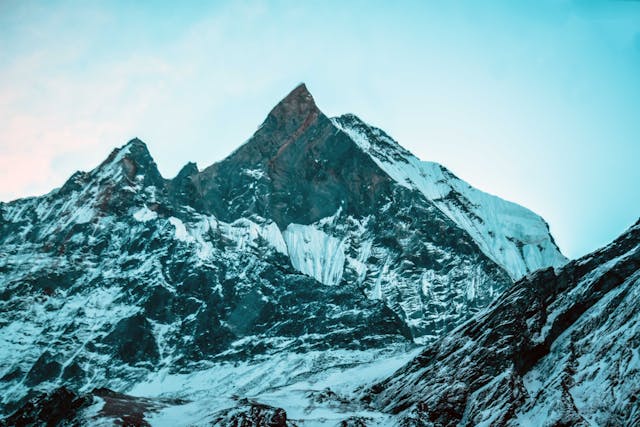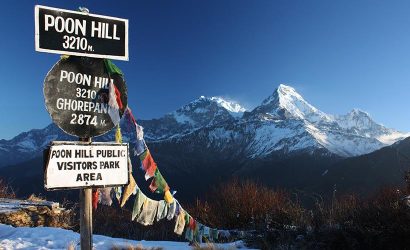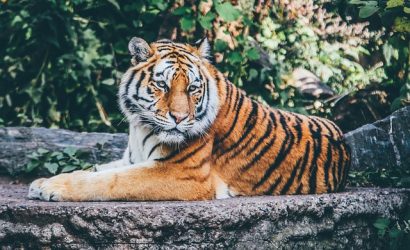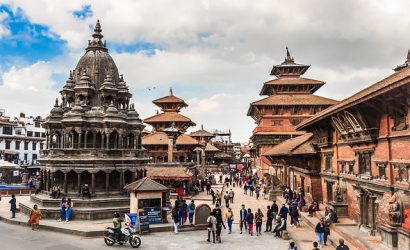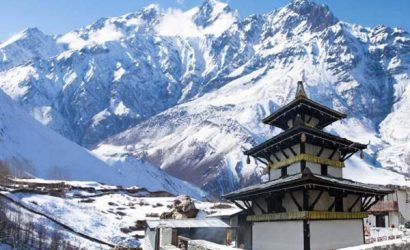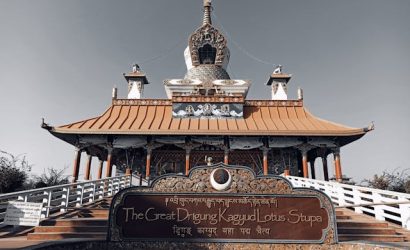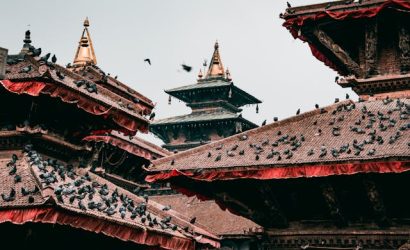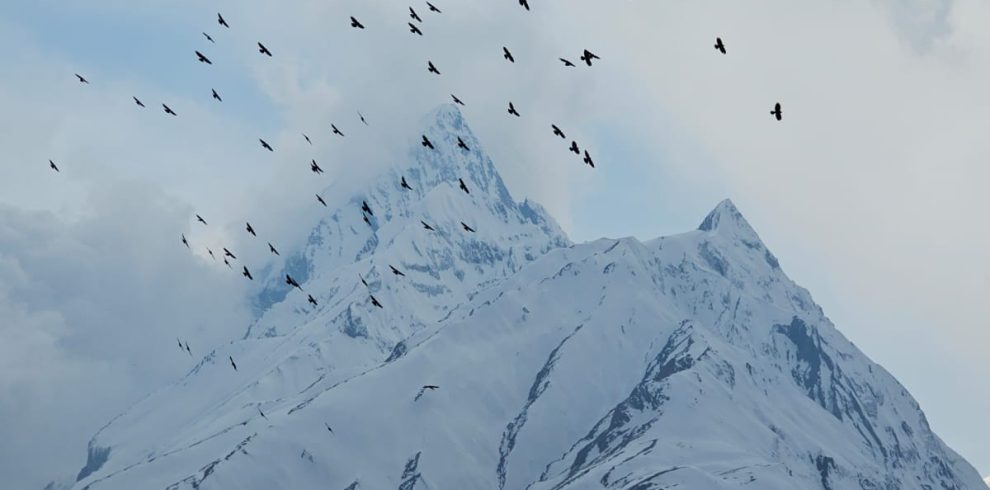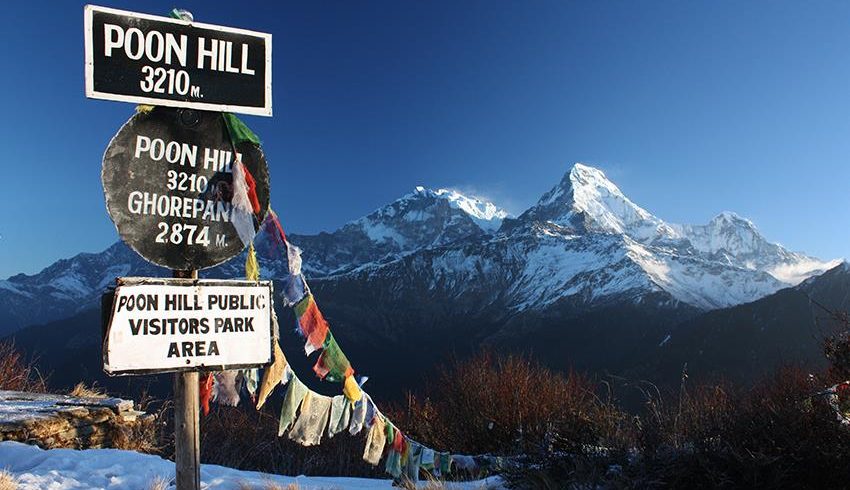The Manaslu Circuit Trek offers a classic walk through the most diverse terrains, beginning in the lush sub-tropical foothills, ascending to a snow-covered high pass in the Himalayas, and extending into a stunning arid region. This trek presents a rich tapestry of landscapes and cultural experiences, providing trekkers with a unique and varied adventure.
Trip Info
-
Annapurna
-
5,416 m / 17, 769 ft.
-
B|L|D on Trek, |B| in KTM & PKHR
-
Teahouse & Hotel
-
Car & Tourist Bus
Overview
The Annapurna Circuit trek in Nepal encompasses the vast Annapurna mountain range, featuring diverse landscapes from lowland villages to high-altitude Himalayan terrains. This trek showcases a rich variety of wildlife and vegetation, alongside a harmonious blend of cultures. The journey is enriched by encounters with the Gurung, Brahmin, Magar, Manangi, Thakali, and other communities, offering a vivid cultural experience. Notably, there is a distinct transition in the architecture from the paddy field houses to stone houses connected by narrow alleys at higher elevations.
A key highlight is visiting Tilicho Lake, one of the world’s highest freshwater lakes at 4,919 meters, revered as a sacred site. Another highlight is crossing the Thorung La Pass at 5,416 meters, providing stunning Himalayan views.
The trek begins at Besishahar in the Annapurna Conservation Area, following the Marshyangdi River and heading northwest towards the Manang region’s mountainous desert. After crossing Thorung La Pass, the trail descends to the Muktinath shrines and follows the Kaligandaki River from Kagbeni. It passes through the Kaligandaki Gorge, one of the world’s deepest, flanked by the Dhaulagiri and Annapurna ranges, and concludes at Ulleri with a drive to Pokhara.
Trip Highlights
- Crossing the thrilling Thorung La pass (5,416m / 17,769ft), one of the highest in Nepal
- Visit one of the most magnificent glacial lakes in the world Tilicho Lake (4919 m)
- The fascinations in and around Muktinath, a sacred Hindu and Buddhist site in the Himalayas
- Hike to the glacial lake of Gangapurna, near Manang
- Multi-cultural experience in the mid-hilly villages like Ghorepani and mountainous settlements of Ngawal, Manang, Khangsar, Marpha, and others with beautiful desert landscapes in abundance
- Guided city tour of the UNESCO World Heritage sites in the historical Kathmandu Valley and the major attractions in the beautiful lake city of Pokhara
Itinerary
You are welcomed by a team member of Access Nepal on your arrival in Kathmandu and escorted to your hotel. In the evening, we meet you at your hotel and discuss your trek and the day city tour over a meeting. Overnight in Kathmandu.
The sightseeing tour of the historic capital city starts in the morning after breakfast. We visit four world heritage sites recognized by UNESCO within the valley, viz. Pashupatinath, Baudhanath, Kathmandu Durbar Square, and Swayambhunath. A private vehicle is arranged for you as you proceed to the first cultural site along with your tour guide.
At Pashupatinath, you can see exceptionally carved statues and idols of Hindu deities. The main temple built in the native pagoda-styled with a golden pinnacle is the highlight. A long row of Shiva Lings, a series of small temples are some instances of the artwork that you can witness. Funeral rituals along the Bagmati River is an integral part of this sacred site. Up next, Baudhanath sits peacefully amidst a square just adjacent to a busy road. It is a large dome-shaped stupa with colorful prayer flags fluttering from the golden pinnacle to the base surrounded by interesting cafes and souvenir stores.
We continue to Kathmandu Durbar Square. The exemplary wooden and stone craftsmanship alongside the stone-paved streets and pagoda-styled religious monuments devoted to Hindu deities are the cultural delights that date back to ancient and medieval Nepal. Later we visit the stupa of Swayambhunath. It translates to self-created. Flanked by other temples and monuments, this hilltop heritage site is a sheer delight. To add to the attraction, a major portion of the city can be viewed from up here. After completion of the tour, we drive back to the hotel and check our trekking gear and equipment. You may explore the jovial Thamel market if you have time.
After breakfast, we start our journey to the starting point of the Annapurna Circuit trek. We drive along the Kathmandu-Pokhara Highway through towns, and paddy fields and over numerous short and long bridges to reach Dumre. We then follow the road above the Marsyangdi River and arrive at Besishahar about 7 hours later. Later in the afternoon, we explore the town of Besishahar. Dinner and overnight at Besishahar.
The drive along the Annapurna Circuit starts in the morning after breakfast. A motorable road has virtually replaced the trekking trail but the scenic beauty still remains as beautiful.
We drive along the serpentine country road through paddy fields and villages with the view of Himalchuli and Ngadi Chuli gracing us. Thereafter, we cross streams and drive past cascading waterfalls aplenty. As we traverse the pine and fir forests near the village of Bagarchhap, we can savour our first view of the Annapurna. Up ahead, the landscape starts to change noticeably, as pine and fir forests replace the lush vegetation and sparse houses supersede dense villages. The trail now climbs up the Manang Valley to Danakyu offering glimpses of Lamjung Himal, Annapurna II, and Manalsu. It is followed ahead by a series of ups and downs past buckwheat fields, apple orchards, and forests before we arrive at Chame to stop for the night. If you’re up for it, we have the option of enjoying a hot spring pool.
Without further ado, we start the Annapurna Circuit trek by crossing a suspension bridge over the Marsyangdi River. The trail passes a pine forest and apple orchard with a few ups and downs before we arrive at Bhratang village. Later, the trek continues along a leveled trail, followed by a suspension bridge and then a steep climb through the pine forest to Dhukur Pokhari. Here, we are welcomed by views of Pisang Peak and Mt. Chulu along the trail to Upper Pisang. We take the higher trail which leads to Upper Pisang. Almost an hour later we reach our stop for the night. In the afternoon we may explore the traditional houses along with monasteries. The panoramic view of the Annapurna range is a delight.
At the start of the day’s trek, we pass through a ‘Kani’ gate and then navigate a serpentine path against the side of a mountain up ahead. A densely forested trail is also part of the trek before we arrive at a suspension bridge. On the other side, the trail climbs up before we arrive at the picturesque village of Ghyaru. Walking along the narrow stone-paved alley, through clustered stone houses with thatched roofs makes the walk intriguing. The trail ahead mostly levels out with a gradual climb in some sections. A welcome gate marks the arrival of Ngawal where we stop for the night with spectacular views.
The trek starts along a pleasant trail through fields and past a few monasteries as we exit Ngawal. We are accompanied by the beautiful Annapurna on the left. The trail drops gradually to the Julu River and we continue the descent all the way to reach the beautiful village of Braga. More impressive desert scenery highlights the trail ahead while the gigantic Annapurnas soar above. We pass mani walls, chortens, and streams with grind mills to reach Manang, half an hour later. A brief exploration before our overnight at Manang.
After continuous days of trek and with the altitude gain significant, we enjoy our day of acclimatization in the stunning ambience of Manang. The town of Manang is placed on a plateau as the majestic Annapurna and Gangapurna mountains soar above. The scenic glacial lake view of Gangapurna is our perk for the morning hike. It is a two-hour walk (both ways) below the town. We can enjoy spectacular views of Gangapurna, Annapurna III, Annapurna II, Pisang, and other peaks in the western part of Manang Valley from around the lake and the Chongkor viewpoint. We head back to Manang, enjoy lunch and further explore the fascinating medieval town of Manang with traditional houses and narrow alleys. The remaining time may be spent in rest and relaxation. We may also indulge in shopping at the well-stocked stores and eateries in the town before we call it a night.
As we resume our trek, the trail splits into two from a mani structure. The path to Tilicho branches off to the left. Up ahead, crossing the suspension bridge over the Khangsar River allows us to switch to the southern mountainside trail. We arrive at Khangsar about two hours later. The trail now inclines steeply. The red structures of the Thare Gompa lie alongside the trail. About half an hour’s climb later, we reach Shree Kharka. The section of the trail ahead is a gradual climb but involves carefully traversing a major portion of a mountain slope, quite prone to rockslides. As we get around the ridge, the mystical Khangsar Kang appears just around the corner and Tilicho Peak can be seen on the horizon. The trail drops gently along the mountainside and leads across the stream to Tilicho Base Camp.
At daybreak, we start the hike to Tilicho Lake. It is going to be a good 4 to 5 hours adventure, so we carry some food with us. At 4919 m, it is among the most spectacular glacial lakes in the world measuring 4 km in length and 1.4 km in width.
We slowly cover the long ascent to avoid altitude illness and also to soak in the visual delights as we trudge along. Khangsar Kang (7485m), Tarke Kang (7193m) are some prominent peaks. The major part of the trek is along the mountain ridge trail. The latter portion is mostly along a gentle slope with broad pathways. As we approach Tilicho, the view gets grander. The spectacular view almost feels unreal! On a clear sunny day, the reflection of the beautiful blue sky appears even more dazzling on the lake. We spend some time by the lake and experience the glacial wilderness. We have some refreshments at the teahouse and prepare for our return descent to Tilicho Base Camp. From here, we follow the same trail all the way to Shree Kharka where we stop for the night.
The trek resumes as usual after breakfast. We follow the trail that goes past Old Khangsar. The trail climbs gradually onto a ridge that opens up to a view of the Manang Valley down below. The section of the trail ahead has a possibility of Himalayan blue sheep (naur) sightings and yaks can be seen grazing in the pasture. We cross a suspension bridge over the Thorung Khola to reach Karche on the other side. The trail climbs gently and meets the main circuit trail from Manang. Almost two hours later, we reach the village of Yak Kharka (meaning Yak pastures) with large herds of yaks grazing on the pastures, which gives the village its name. The ascent resumes with a gradual climb for about an hour to reach Ledar (Letdar) Village.
The trail ahead continues to climb before it takes a descent lasting about an hour to a narrow wooden bridge over the Jorsang Khola (River). On the other side, after a brief climb, we walk a narrow trail that cuts through a steep slope. The walk continues for an hour and we make the final short ascent to arrive at Thorang Phedi. We push the ascent a bit further to reach Thorung High Camp to stop for the night.
After a wholesome breakfast, we prepare for the toughest section of the Annapurna Circuit Trek. Crossing the Thorung La pass averages about four hours. Before we set off, the current weather needs to be taken into serious consideration. The climb resumes alongside moraines before a cluster of prayer flags signal the nearing of the pass. On reaching the highest point of the trek at 5416m (17769ft), we are treated to magnificent views while the congratulatory sign adds to the excitement. The Annapurna massif, Gangapurna, and Khatung Kang peaks along with the Kaligandaki Valley (to the west) and the arid Manang Valley (to the east) make up the southern view, and the Yakwakang peak can be seen in the north.
We now have ahead of us a steep descent (over 1600m / 5249ft) all the way to Muktinath. The initial part of the descent requires careful navigation as the melting snow renders the trail slippery. Eventually, the descent gets pleasant as we continue downwards and start to walk past green meadows and vegetation. On arriving at Muktinath about four hours later, we leave the detailed exploration for the next day and head to our lodge to get dinner and a good night’s rest.
After breakfast, we head to the sacred area of Muktinath in the early morning. Monuments to explore on the premises of Muktinath include the popular 108 brass waterspouts, the Shiva and Vishnu temples flanked by other shrines, the Gompa Sambha monastery, and the Jwalamai temple (with a burning flame of natural gas) among others.
Next off, we are up for a drive of about 70 km along the country road. The first section of the drive up to Kagbeni is quite interesting as you pass through medieval fortified towns like Jharkot and Khingar where the traditional stone houses and monasteries are quite a sight. The drive continues to Eklebhatti via Kagbeni. From here onwards, the drive is along the Kaligandaki River all the way to Tatopani. To our sheer delight, the scenery includes plenty of desert landscapes with oases of apple orchards and paddy fields. Moreover, Tukuche Peak, Mt. Annapurna I, Nilgiri, and the Dhaulagiri range may also be witnessed on the way. At Tatopani, you may treat your sore muscles to a well-deserved relaxation at the natural hot water springs down towards the river. Overnight at Tatopani.
We start with a brief descent to cross the Kaligandaki River before chasing the trail to Ghorepani on the other side of the suspension bridge over Ghara Khola. Then, we take the steep uphill trail that leads to the village of Shikha. This section of the Annapurna Circuit trail is quite interesting and leads to the more frequented region of the Annapurna.
An early morning hike to the Poon Hill viewpoint offers a beautiful sunrise view over the panorama of the Annapurna and Dhaulagiri ranges. Annapurna I (8091m), Dhaulagiri I (8167m), Nilgiri (6940m), and Tukuche (6920m) can be witnessed from here. After a return hike to Ghorepani, we have breakfast at the teahouse and prepare for our hike down to Ulleri. The hike to Ulleri begins along a gradual trail and then drops steeply after Nangethanti. Eventually, we find ourselves walking through a dense oak and rhododendron forest. It is a beautiful walk, particularly during the Spring season with the wildflowers in full bloom. We arrive at Banthanti shortly and then make our way down to Ulleri. We then navigate the winding country road to Birethanti before joining the highway that leads to Pokhara, marking the end of our Annapurna Circuit trek.
Next, we continue our walk through the rhododendron forest for almost three hours before reaching the village of Ghorepani. The Gurung village is worth an exploration trip before we end the day with dinner and some rest.
An early morning hike to the Poon Hill viewpoint offers a beautiful sunrise view over the panorama of the Annapurna and Dhaulagiri ranges. Annapurna I (8091m), Dhaulagiri I (8167m), Nilgiri (6940m), and Tukuche (6920m) can be witnessed from here. After a return hike to Ghorepani, we have breakfast at the teahouse and prepare for our hike down to Ulleri. The hike to Ulleri begins along a gradual trail and then drops steeply after Nangethanti. Eventually, we find ourselves walking through a dense oak and rhododendron forest. It is a beautiful walk, particularly during the Spring season with the wildflowers in full bloom. We arrive at Banthanti shortly and then make our way down to Ulleri. We then navigate the winding country road to Birethanti before joining the highway that leads to Pokhara, marking the end of our Annapurna Circuit trek.
After breakfast, we board the tourist bus back to Kathmandu. The drive is along the Prithvi Highway along the hilly road that goes over numerous bridges, towns, and sub-urban fields. On reaching Kathmandu, you are escorted to your hotel. In the evening, a farewell dinner is organized with the team as we revel in the beautiful memories during the trek.
The Annapurna Circuit trek has ended, and for a change, you do not have to attend a wake-up call to be ready for the day’s trek. You may choose to spend the last day in Kathmandu as you prefer. We would be happy to recommend you more places of interest for exploration or outdoor activities like rafting, climbing, cooking local cuisine, and leisurely or spiritual sightseeing. A private vehicle for your airport drop-off is arranged. Hope to see you again!
Cost
Cost Includes
- Airport pick-up and drop
- 3 nights accommodation in Kathmandu - 3 Star Standard (Breakfast Included)
- 1 nights accommodation in Hotel Batika, Pokhara or Similar - 3 Star (Breakfast Included)
- Kathmandu - Besishahar transfer on a bus (Day 3) & Pokhara - Kathmandu transfer on a Deluxe Tourist Bus (Day 18)
- 13 nights accommodation in Local Tea Houses during the trek (Breakfast, Lunch and Dinner Included)
- Accompany of Licensed English-speaking trekking guide for the entire trip (Trained in First-Aid and Emergency Evacuation)
- One porter for every two clients (13 Kg luggage per person) - salary, insurance and personal expenses covered
- A cup of tea/coffee (three times a day) and seasonal fruits after dinner on the trek
- Attached bathrooms and hot showers wherever available
- Transfers during the trek in a shared jeep: Besishahar to Chame (Day 04), Muktinath to Tatopani (Day 14) & Ulleri to Pokhara (Day 16)
- Trekking permit (TIMS) and Annapurna Conservation Area Permit for the trek
- First-Aid box with medicines (Carried and handled by the guide)
- Private AC vehicle during the sightseeing tour
- Accompany of Licensed, English-speaking, well experienced city tour guide with salary and personal expenses covered during the sightseeing tour
- All applicable government charges
Cost Excludes
- Nepal Visa and International airfare
- Travel Insurance (Compulsory) - must cover helicopter evacuation, medical expenses, and Trip Cancellation charges
- Meals in Kathmandu except for breakfast and farewell dinner
- Personal equipment and other personal expenses such as beverages, confectionaries, laundries, etc.
- Monument Entrance fees during the sightseeing tour
- Extra meals, extra porterage service, Wi-Fi, charging of your electronic devices, etc.
- Tips to your guide, porters, driver and other field staff as a token of appreciation
- Any other expenses or charges not mentioned in the 'Trip Includes' list
The Annapurna Circuit trek is an extraordinary journey for several compelling reasons:
- Diverse Landscapes: The trek encompasses a wide range of landscapes, from lush lowland villages to high-altitude Himalayan terrain, offering trekkers a varied and scenic experience.
- Cultural Experience: The trek provides an enriching cultural experience as it passes through villages inhabited by the Gurung, Brahmin, Magar, Manangi, Thakali, and other communities. The architecture and lifestyles shift noticeably with the altitude, adding depth to the cultural immersion.
- High-altitude Lakes and Passes: Highlights include the visit to Tilicho Lake, one of the highest lakes in the world, and crossing the Thorung La Pass, which offers breathtaking views of the Himalayas. These features provide both spiritual and adventurous aspects to the trek.
- Wildlife and Vegetation: The variety in wildlife and vegetation, including the diverse flora and fauna of the Annapurna Conservation Area, adds to the trek’s allure. The area is home to numerous species, making it a haven for nature enthusiasts.
- Scenic Highlights: The trek offers magnificent views of peaks such as Annapurna, Dhaulagiri, and Machhapuchhare, and the Kaligandaki Gorge, one of the deepest in the world, provides dramatic scenery that enhances the trekking experience.
- Historic and Sacred Sites: The trek includes visits to sacred sites like the shrines of Muktinath and various monasteries, adding a spiritual dimension to the adventure.
These aspects make the Annapurna Circuit trek a holistic and fulfilling adventure, blending natural beauty, cultural richness, and spiritual significanc
Choosing Magical Nepal Treks for your Annapurna Circuit adventure offers several key advantages that enhance your trekking experience:
- Expert Guidance: Our experienced, licensed guides bring a wealth of knowledge about the region’s geography, culture, and history, ensuring you get the most out of every aspect of the trek.
- Personalized Itinerary: We offer a flexible itinerary tailored to your fitness level and interests, including acclimatization days to ensure your comfort and safety at high altitudes.
- Comprehensive Services: From airport pick-up to accommodation arrangements, meals, and necessary permits, we handle all logistics so you can focus entirely on the experience.
- Cultural Immersion: Our treks emphasize authentic cultural interactions, providing opportunities to engage with local communities and understand their way of life deeply.
- Safety Priority: We prioritize your safety with well-planned routes, regular health check-ins, and contingency plans for emergencies, including insurance that covers helicopter rescues if needed.
- Environmental Responsibility: We practice eco-friendly trekking, ensuring minimal impact on the environment and supporting sustainable tourism in the region.
- Competitive Pricing: We offer competitive pricing without compromising on quality, providing excellent value for a comprehensive trekking package.
Choosing Magical Nepal Treks ensures a well-rounded, safe, and enriching trekking experience in the stunning Annapurna region.
If you are physically fit and guided by a sense of adventure, you would love trekking! The mountains and hills of Nepal have trails that match all abilities. The remotest trails that are mostly unexplored to well-marked trails with ample facilities, Nepal has it all.
The prime challenges trekkers face in the trekking regions are language barriers and navigation. A major section of the vast Annapurna Circuit trek region is uninhabited and in the remaining sections that are, the locals hardly understand English or other foreign languages. Weather conditions and other unanticipated challenges can make it difficult to plan the day’s trek, meals and shelter options. A wrong turn could push you off the trail into harm’s way.
A guide on the other hand eases things for you, enriches your experience and ensures safety. Guidance that comes from experience and deep local knowledge lets you enjoy and make the most out of your trip while you leave the arrangements and planning to your guide who becomes an important part of your team.
There is no specific age limit. Trekkers as young as 6 and as old as 75 have trekked in the Himalayas. However, trekkers under the age of 18 are required to be accompanied by a guardian. Younger trekkers should only be brought along if they can be appropriately cared for and can properly communicate any problems to their guardian.
The Annapurna Circuit trek can be challenging to strenuous (at certain sections, viz. Tilicho Lake and Thorung La pass) at times based on the terrain, the number of trekking days, time of the year and current weather conditions. It also depends on previous trekking experience, recent exposure to high altitudes, and the skill of the trekker.
It is preferable, but not necessary. However, physical fitness and the ability to cope with strenuous conditions in high altitudes is necessary to make the experience a pleasant one. It is therefore recommended that you begin physical training, involving cardiovascular workout and stamina enhancement months ahead of the trek.
Although the destinations in lower altitudes can be trekked throughout the year, Spring (February to May) and Autumn (October to December) are the best times to trek in high altitudes. Nepal receives monsoon rain from June through September, which is not a great time to trek. However, the rain shadow areas of Upper Mustang, Dolpo and Nar-Phu near the Annapurna region offer a great escape during the season. Winter is very cold in the upper mountains with heavy snowfall which often cause obstructions in the trekking routes.
A Trekkers’ Information Management System (TIMS) card is necessary for most trekking regions including the Annapurna Circuit Trek. Additionally, an entrance permit is required for protected areas such as the Annapurna Conservation Area. Upon confirmation of your booking, we acquire all necessary permits on your behalf.
The average trekking hours is around six hours. It can range from four to eight hours a day depending upon trail conditions, day of the itinerary, and weather conditions.
All treks with an exception of a camping trek include accommodation in a mountain lodge or guest house for overnight stays and meals. The rooms are on twin-sharing basis. The facilities in lower altitudes also offer an attached bathroom with hot shower.
The nationwide expansion of mobile networks has made it possible to enjoy 4G and 3G networks in most parts of the Annapurna Circuit Trek up to moderate altitude. A sim card for NCell and NTC, the leading mobile telecommunications providers can easily be availed. Uninterrupted connection however is greatly affected by weather conditions and terra
A good level of overall fitness, sound health and stamina is necessary to go on and enjoy the Annapurna Circuit Trek. If you have any chronic or acute health condition, we recommend that you consult your physician before signing up for the trip. Practice hikes or cardiovascular workouts at least a few months prior to the trek would ensure better coping with high altitude and enhanced stamina levels. These can improve your trekking experience significantly.
It is a known fact that oxygen levels at higher altitudes are significantly lower than the level that we are used to and the body needs to adjust to this change in atmosphere. The best way to aid acclimation is to climb slowly. We have prepared our itinerary to allow enough time for acclimation and not put too much of strain on the body. Adequate acclimation days, a combination of rest and a short hike have been arranged to further support the process. Minor symptoms of altitude sickness include severe, persistent headache, coughing, pressure in the chest, shortness of breath even while at rest, dizziness, tiredness, loss of appetite and others. It is vital you constantly monitor your health condition and report any signs of sickness to your team leader.
If you fall sick or get injured despite precautions, our first-aid trained guides would be your first help. Depending upon the nature of sickness or injury, you would either be immediately taken to a lower altitude (in case of altitude sickness) or evacuated by a rescue helicopter for medical attention. We would require your insurance details to arrange for a rescue helicopter if you are injured in a remote area and in no condition to trek further.
Safety of all our guests is our utmost priority. Nepal has been well-known as a safe destination and the Nepalese as friendly and welcoming people. We generally trek in small groups in constant care and company of our experienced and expert guides. The places that we frequently utilize as our stops have been known to be reliable and safe over the years that we have been served. As such the safety of all travelers is ensured.

